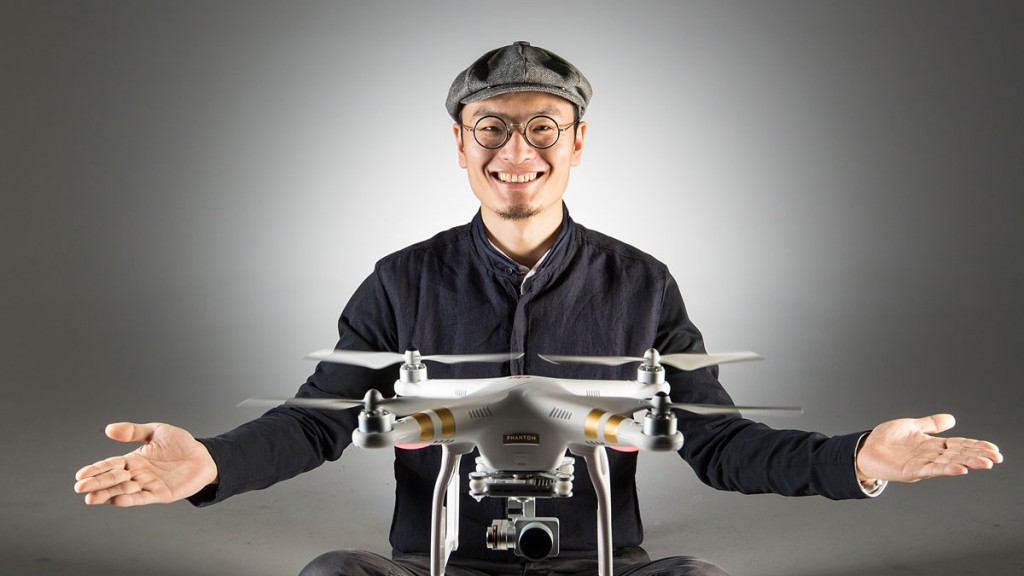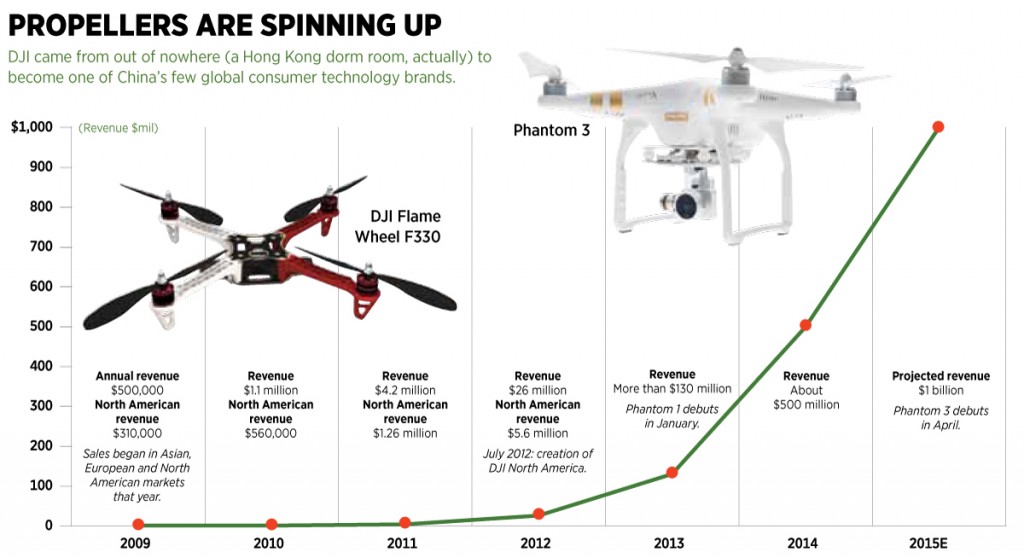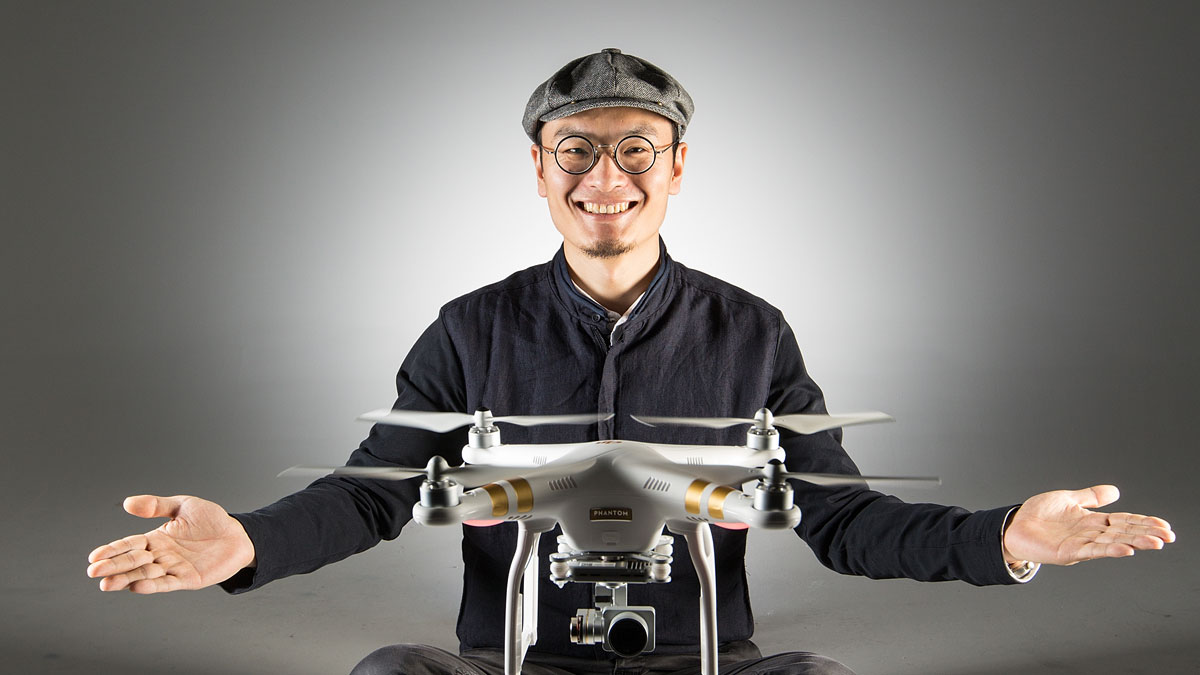Drone Overlord Frank Wang On DJI’s Milestones, Miscarried GoPro Partnership & Corporate Espionage
Via Forbes
This article originally appeared Yesterday by Forbes staffer Heng Shao. It’ a great piece and I feel that Heng is asking the same questions I myself would be interested in and probably you would too.

At age 34, Frank Wang Tao is leading the global consumer drone industry with Dajiang Innovation (DJI), a Shenzhen-based manufacturer that he founded out of his dorm room nine years ago. On track to do about $1 billion in revenue in 2015, DJI pioneered the popular market for flying robots largely with its signature Phantom, a white-shelled, pre-assembled drone that can be flown almost right out of the box.
But unlike other Chinese technology giants such as Alibaba and Xiaomi, which grew big mainly by tapping into the enormous consumer market in their home country, DJI derives about 70% of its sales from outside of Asia. It is the first Chinese company to lead a global tech revolution.
In three sit-down interviews with FORBES, Wang shared stories of DJI’s early days, his drive as a “perfectionist” and challenges that the company faces ahead. His focus has allowed him to accomplish a childhood dream of creating a flying robot, and he now heads up the largest consumer drone maker in the world. (To read more about Wang’s story see this month’s feature on DJI here.)
Below are selections from Wang’s interviews with FORBES, edited for clarity.
Forbes: When did you first become interested in flying robots?
Frank Wang: There was a comic book in the 1980s called “Dong Naojin Yeye” (Grandpa Think-Hard) which featured a red helicopter. I remember it so clearly. I imagined that I’d make a plane like that, that could follow me when I’m hiking or on the train, and use a camera to send the images to me. Actually at the time I didn’t even know the concept of a camera. I just wanted to fly so badly. Even though I couldn’t turn myself into a plane, I was happy to just make a small plane and watch it fly.
F: How did the company start?
FW: I completed [a helicopter flight control college project] in 2005. I founded the company in 2006. At the time I made a video of the helicopter and the people who watched it thought it wasn’t bad. Someone then approached me to buy it. I thought it was a good deal because I sold it for RMB 50,000 (about $6,000) while it cost RMB 15,000 (about $2,000) to make.
F: What were the challenges you faced in the early days?
FW: Almost all of the first group of employees left after two years. They may have felt the future was a question mark… I was a perfectionist, and was abrasive when it came to interacting with other people.
To give you one example: I believed that whoever contributed more should be given more shares. At the time we had three to four employees and I wanted to give each of them shares, but I thought the share amounts shouldn’t be equal. Whoever contributed more should be given more. It shouldn’t be egalitarian. But at the end I pissed everyone off. I pissed off the person who was given fewer shares. He felt that it was unfair so he left. But I also pissed off the person who was given more, [because] he asked if he could gift his shares to the other person. I said, “No, you have to take more shares.” We had some arguments and my tone was insensitive and I said something like, “At this company I am in charge.” When he left the company, he said this incident made him feel hurt.
F: You began with making flight control systems for helicopters but later moved onto making quadcopters. What triggered that transition?
FW: A New Zealand distributor told us that she sold 200 gimbals a month, and 95% of the customers installed the gimbals on multirotors. Initially we thought light of multirotors because they couldn’t carry much weight or fly for long. But when the dealer told us this information, we thought about seriously making a [flight controller for quadctopers.] In fact most of the stuff was the same and we could use our software on multirotors with some small changes… The hardware hardly needed any changes and so we made our first flight control for a multirotor in just a few months, selling for RMB 6000 to RMB 7000 (about $700 to $800). It was successful right away.
The main players in the multirotor market back then was an open source company from Germany called MikroKopter. It was mostly do-it-yourself, and you had to find your own components and download your own code, so the user experience wasn’t great. Neither was the product’s reliability. We were the first one to provide a commercial-use, off-the-shelf [multirotor] flight control.
The multirotor market was rather primitive back then. We sold a few hundred units a month, and I believe we had 70% of the market at the time just like we do now.
F: How did you market your products at the time?
FW: We were mainly just going to exhibitions and putting ads on hobbyist websites. We didn’t have any advertisement for the mass consumer market yet…. The first time we went to an exhibition at Nuremberg, Germany we were placed in the China section, with one of those cheap and small booths, right next to stuffed animals…We were not even in the model section, we were in the toys section.
The second year we had a better booth, and released our new product, the Zenmuse driver-stabilized gimbal. People thought it was amazing because it was the first time that anyone used “direct drive technology” in aerial imaging and we moved up the industry standard by tens of times. That was when we felt that a lot of people in the industry began paying attention to our company.
F: The biggest success has been the Phantom, which was first released in Jan. 2013. How did you come up with the idea?
FW: At the time we thought we should make an entry-level product to prevent competitors from waging a price war. We wanted to make a product that was cost-effective, ready-to-fly and didn’t need [to be built by users.] But the consideration was really to prevent our competitor from entering the low-end market, and we didn’t even think of making money.
But the Phantom turned out to be the product that brought in the highest sales. Initially we made professional products, had a good market share and the profit margin was alright. But later on it became the reverse. Our entry-level phantom surpassed our professional products.
F: Who were your main competitors back then?
FW: We had only two competitors from China. There was a Beiing-based company called Zero UAV, which competed with our high-end product line, the S800, and X-Aircraft [based in Guangzhou) competed with our entry-level product Flamewheel…[Outside of China,] there was maybe 3D Robotics.
F: The latest Phantom series releases carry their own cameras but when the original Phantom came out, most customers used GoPros. Did you have GoPro in mind when you built the first Phantom?
The first generation of the Phantom didn’t have its own camera. GoPro is a relatively good off-the-shelf camera that you could install on the Phantom. But we’ve had our own camera from Phantom Vision on, and of course we still have products that are compatible with GoPro cameras. It will be like this in the future: we have better and better cameras, but customers can still choose to use a GoPro.
F: But was the first Phantom designed specifically for the GoPro camera?
FW: We are not willing to be someone else’s accessory, but a lot of our customers had the need [to use a GoPro camera for aerial footage], so we made a product like this. However, from the beginning to now, we never wanted to be in the shadow of someone else. The camera on our Inspire is already better than GoPro’s best camera.
In the past, it wasn’t like we couldn’t make good cameras. Our supplier sold the best chips to GoPro, and only sold us the second-grade chips because we were not big enough. For Phantom Vision, our camera was one generation behind GoPro’s…. But our newest camera is better than GoPro’s because we convinced the supplier to sell us the newest generation of chips.
F: If I were GoPro I’d be pretty pissed off. They could have partnered up with you had you not made a product with your own camera.
FW: We discussed with GoPro at the time. Initially [GoPro and DJI] wanted to make a product together for GoPro to sell, but the negotiation never came to fruition….They treated us like the original equipment manufacturers (OEM). The deal came out to roughly this: GoPro would make two points of profit, and I’d make one point. I didn’t want it like that. I thought it should be, I make two points of profit, and [GoPro] makes one point of profit, because the product, from the beginning to the end, would have been mine. [GoPro] was only a sales channel. They dealt with us like how they dealt with Taiwanese OEMs, so we never had a successful official partnership. Unofficially I still made their gimbal, which was good for both sides.
F: In previous interviews you said you always felt aggravated as a Chinese national because China doesn’t have good products. Can you explain this?
FW: Chinese people learn English from a young age. Chinese people think imported products are good and made-in-China products are inferior. We’re always second-class. So I have no sense of achievement. It’s like, your mom gave birth to you, but your mom is ugly. What can you do? You can’t despise your mom for being ugly because you have her genes too.
I’m unsatisfied with the overall environment, and I want to do something to change it.
F: We often hear comments that say DJI doesn’t seem like a Chinese company. Have you tried to project a non-Chinese image on purpose?
FW: We thought of setting up a shell company in Germany, but ultimately decided not to…we mostly felt it was unnecessary, and it also made us uncomfortable from an integrity point of view. Could you pretend to be something you’re not? Even if you could, you wouldn’t be living the life you want.
F: DJI’s growth has benefited a lot from technological breakthroughs with each of your new products. What happens when you reach a point where you can only make marginal improvement in the technology instead of breakthroughs? Will your competitors have the chance to beat you then?
FW: The stage you described will come in three years. Our competitors had better survive until then. I believe this industry, by that point, would become low-margin… But that all depends on DJI’s pace. If DJI wants the industry to be low-margin, it will be low-margin. If DJI wants it to stay high-margin, then that will remain the case for a big longer. We must be extremely aggressive going forward.

F: What was the most memorable moment for you as an entrepreneur?
FW: The most memorable moment for me was when our helicopter automatically hovered in the air [for our senior class project] in January 2006. That was a good time. Nowadays so much of what I do is management… like catching spies. As for what I like the most, products, I have to depend on my colleagues to make them. Sometimes they churn out products slowly and I wonder if I was wrong in criticizing them. I wonder whether they are doing something stupid or being lazy, or if they are doing things right and trying hard.

ADVERTISEMENT
F: Can you elaborate on “catching spies”?
FW: We found out that someone was stealing our code. The Shenzhen Police registered the case and the Shenzhen government has been supportive too…We also had an employee who collected blueprints before leaving and later sold them.
Our second employee, the one that left [because he didn’t get enough shares], sold a copycat flight controller of ours. How did I find out? He was betrayed by his customer who wanted to get a deal with us by betraying him. And you know how the employee made the copycat product? He employed someone who was still working for us and used facilities inside the company.
This [incident] is a microcosm of the society, where dogs bite dogs. In such an environment, DJI would not have taken off without wings… If our products are great, we can ignore those people and can still move on. I hate this culture where dogs bite dogs.
Foreigners are born in better environments and may do things with more openness. For example, you can make your code open source without worrying that someone might copy you. But if you do this in China, you will have tons of copiers.
F: It sounds like you face quite a bit of managerial challenge. I heard the purchasing department is one of the most difficult departments to deal with at DJI. How is that the case?
FW: The most serious issue with the supply chain is kickbacks… Each month our purchase amount is tens of billions in RMB, so even if the purchasing staff was taking just 1% kickback, it was still a lot of money.
We had a supplier who sold us products at very high prices, but later on decided to discontinue our partnership. I was puzzled: By selling to us, they were earning more money than if they had sold to others. So why didn’t want to do business with me? Later on I found that, that if our purchasing staff were not pampered well enough they’d make things hard for the suppliers. For example, they would give suppliers an order to be fulfilled immediately, which would have been impossible to do. Or they would cancel an order, or give suppliers a hard time in quality inspection.
Almost all the staff in the department were let go last year. It was a department of more than 10 people. We now have a competitive mechanism set in place for the purchasing department but I can’t talk about what it is exactly. It’s a business secret.
F: What’s the next step for DJI and what’s your vision for the drone industry?
FW: Nowadays we are still focused on doing well in making flying cameras. We’re enabling other applications with our software development kit such as agriculture and government functions. But we can’t predict too far, so we will see how things go as we move along. Our goal is to maintain 100% growth in sales in the next two years… If we can do that, I believe we will have 90% of the market.
Flying cameras should become at least as popular as DSLR cameras. Families with the need for DSLR would at least buy a drone, which is much more fun. In the end the drone will become a toy for the adults.






But Bezos’ news announcement, and the timing of that announcement, is something to be admired.
Sally and Elliott will both give you alien weapons if you show back up on the ship.
The distance can be extended if the drone is followed by the operator.